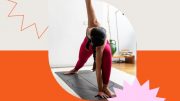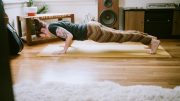I resided in off-campus accommodation in New York City throughout my college years, about a mile from the closest Trader Joe’s.
I couldn’t face the thought of going to the regular supermarket on my street, even though I was an Everything But the Bagel lover. As a result, I went to TJ’s every Sunday morning, carrying my groceries and sweating through my t-shirt.
If you’ve ever carried a watermelon a mile, you know that lugging a shopping bag qualifies as a core workout. But, according to SLT founder and Pilates trainer Amanda Freeman, carrying a grocery bag isn’t the only ordinary action that can replace crunches, plank holds, and mountain climbers.
We’re basically always using our core, whether we realize it or not (the apropos term for the system of muscles that helps stabilize the trunk of the body).
According to Freeman, “core strength is a crucial contributor to practically each movement your body does.” Your core is working whether you’re using your arms, legs, or both, and it can help maintain your body injury-free during any exercise, according to her.
As a result, if your core is weak, you’re more likely to get hurt doing ordinary activities like bending over to get something or lugging your laundry up the five-story walkup’s stairwell.
That’s why it’s crucial to double-check that you’re following these movement patterns while maintaining proper form. When you do go to the gym, you can target your core to make these motions feel effortless.
Freeman breaks down five commonplace actions that work your midsection in the following paragraphs. She also explains how to perform each one correctly, as well as what core workouts you can do to make these maneuvers easier.
5 core-stretching activities that are equally as effective as a core workout
1. Vacuuming and dusting are required
Cleaning your house may not come to mind when you think of core workouts, but according to Freeman, when you dust and vacuum, you’re also working your abdominals, trapezius (the muscles between your shoulder blades), and obliques (side body muscles).
Proper vacuuming and dusting technique: She recommends following a few important cues to avoid injuring yourself while freshening up your environment. “When bending over to reach hard-to-reach locations, engage your core throughout and keep your back flat,” she advises.
Supplemental core work: Working on your deadlift, which simulates a flat back and core engagement while strengthening your hamstrings, can help you strengthen the muscles you need to bend over safely.
2. Grocery shopping
Carrying groceries, in addition to exercising your core, is an excellent arm workout, according to Freeman. “Though various upper body muscles are stimulated, the biceps are the key muscles involved in carrying goods,” she notes.
Proper grocery-carrying form: She recommends properly spreading the weight between both arms and standing up straight to engage your core to carry goods in a safe manner. You can request that whoever is bagging your groceries fill your bags such that they are all roughly the same weight. As a result, neither arm will bear the brunt of the weight.
Supplemental core work: Simply practicing your plank holds can improve this same set of muscles.
3. Climbing stairs
“Climbing stairs is such a good glute, calf, and quad workout that stair climbing machines take up a lot of gym space,” explains Freeman. Of course, if you live in a walkup or even a two-story home, you’ll have lots of opportunities for vertical workouts.
Proper stair-climbing form: “Make sure your heels strike the steps, and push off with your heels rather than your toes to train more glutes and less quads,” adds Freeman. (It’s also a little safer than climbing the stairs on your tiptoes.)
Supplementary core work: If you want to make this a bit simpler, simply improve your cardio and endurance by power walking, running, or cycling.
4. Gardening
Gardening, according to Freeman, is the only common activity that can be considered a full-body workout.
“Gardening may be a full-body workout, working your arms, shoulders, stomach, back, and legs, depending on the details of your program. Raking, in particular, works all of your muscles, but even low-intensity planting and weeding work your upper body and core “She clarifies.
Proper gardening form: While tending to your plants and flowers, Freeman advises maintaining your back straight, your core engaged, and moving up and down with your lower body.
“Cherry pickers are a terrific core workout that gives your body good practice securely reaching for something,” she says of supplementary core exercises.
5. Standing up and sitting down
Regardless of your occupation, you certainly spend a significant amount of time sitting and standing each day. This may also be used as a core workout…just make sure you’re doing it right.
“When people’s backs ‘give out,’ it’s usually because they’re doing something as simple as standing up or sitting down. In addition to the core, the act itself activates a range of lower body muscles—quads, glutes, and calves “Freeman agrees.
Proper sitting and rising form: Rather than getting up from your desk on autopilot, Freeman suggests pausing to make sure your core is leading the way.
Supplemental core work: Adding additional squats to your workouts will make toilet breaks and coffee pot runs a little easier.
Hello there! You appear to be someone who enjoys free workouts, unique Well+Good content, and savings on cutting-edge wellness brands. Sign up for Well+, our online network of wellness insiders, and you’ll have quick access to your rewards.





